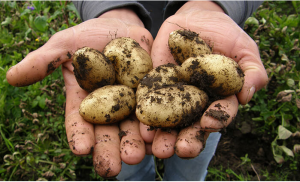
Essential Tips for Knowing When to Harvest Potatoes
Potatoes are one of those versatile vegetables that can be enjoyed in countless dishes. From crispy fries to creamy mashed potatoes, there’s no denying their place in our kitchens. But have you ever wondered about the best time to Harvest Potatoes on your own homegrown? It’s not as simple as just waiting for the plants to die back. In this guide, we’ll explore essential tips for knowing exactly when to dig up your potatoes to ensure you get the best yield and quality. So, grab your gardening gloves, and let’s dig in!
Why Timing Matters When Harvesting Potatoes
Before we get into the specifics of when to harvest, let’s talk about why timing is so crucial. Potatoes have a unique growing cycle, and harvesting at the right time can make all the difference in the taste and storage life of your tubers. Harvest too early, and you might end up with small, underdeveloped potatoes. Wait too long, and you risk diseases or damage to the tubers. Think of it like baking a cake—you wouldn’t want to pull it out of the oven too soon or too late!
Understanding Potato Plant Growth Stages
To get the timing just right, it’s essential to understand the different stages of potato plant growth:
1. Planting
Potatoes are usually planted in early spring. You’ll plant seed potatoes (or chunks of potatoes with at least one eye) a few inches deep in well-drained soil. This is the beginning of their growth cycle.
2. Vegetative Growth
After planting, the plants will start to grow above ground. You’ll see green leaves and stems emerging from the soil. During this time, the plants are focusing on growing and developing.
3. Flowering
As the plants mature, they will begin to flower. Flowering is a sign that the plants are entering the reproductive phase, but it’s not yet time to harvest. The flowers are pretty, but they don’t necessarily indicate that your potatoes are ready.
4. Dying Back
Eventually, the foliage will begin to yellow and die back. This is one of the key indicators that it might be time to start thinking about harvesting.
How to Know When Potatoes Are Ready to Harvest
So, how do you know for sure when it’s time to dig up those delicious spuds? Here are some of the most reliable signs:
1. Check the Foliage
One of the most obvious signs that it’s time to harvest is when the foliage begins to die back. When you see the stems and leaves turning yellow and wilting, it’s usually a good sign that the potatoes are ready. However, don’t rush to dig up your potatoes at the first sign of wilting. It’s best to wait until the foliage is fully yellowed and crispy.
2. Timing Matters
Typically, you should wait about 2-3 weeks after the plants have died back before you start harvesting. This waiting period allows the skins of the potatoes to thicken, which helps them store better. If you dig up the potatoes too soon, the skins might be too thin and could break or peel easily.
3. Look for the Right Size
If you’re eager to check on your potatoes before the foliage completely dies back, you can gently dig around the base of the plants to see if the potatoes have reached a good size. If you see that they’re still quite small, it’s best to leave them in the ground for a bit longer.
4. Test a Potato
If you’re still unsure, you can always test a potato. Dig up one or two tubers from the plant and check their size and skin thickness. If the potatoes are about the size you want and the skins are thick enough, you’re good to go!
How to Harvest Potatoes Correctly
Once you’ve decided it’s time to harvest, you’ll want to make sure you do it correctly to avoid damaging your potatoes.
1. Prepare Your Tools
You’ll need a few basic tools for harvesting potatoes: a garden fork or shovel, and a container for collecting the tubers. Make sure your tools are clean and in good condition.
2. Loosen the Soil
Use your garden fork or shovel to gently loosen the soil around the base of the plant. Be careful not to stab or break the potatoes. Start about 6-8 inches away from the plant base and work your way in.
3. Lift the Tubers
Once the soil is loosened, you can gently lift the tubers out of the ground. Be sure to handle them carefully to avoid bruising or breaking the skins.
4. Remove Excess Soil
After you’ve lifted the potatoes, brush off any excess soil. Be gentle—rough handling can damage your potatoes and shorten their shelf life.
What to Do After Harvesting Potatoes
Congratulations on your harvest! But the work isn’t quite done yet. There are a few more steps to ensure your potatoes are ready for storage.
1. Cure Your Potatoes
Before storing, you should cure your potatoes. Place them in a cool, dark, and well-ventilated area for about 1-2 weeks. This curing process helps to toughen the skins and heal any minor wounds.
2. Store Properly
Once cured, store your potatoes in a cool, dark place with good ventilation. A basement or a root cellar is ideal. Avoid storing them in the refrigerator, as the cold can cause the potatoes to sprout.
3. Check Regularly
Finally, check your stored potatoes regularly for any signs of rot or sprouting. Remove any problematic potatoes to keep the rest in good condition.
Common Mistakes to Avoid
To wrap things up, let’s go over some common mistakes to avoid when harvesting potatoes:
1. Harvesting Too Early or Too Late
This is probably the most common mistake. Be patient and wait for the signs of maturity before harvesting. Rushing or waiting too long can affect the quality of your potatoes.
2. Using the Wrong Tools
Using sharp or heavy tools can damage your potatoes. Stick to a garden fork or a shovel with a broad blade for the best results.
3. Ignoring Soil Conditions
If your soil is too wet or too dry, it can be harder to harvest potatoes without causing damage. Make sure the soil is in good condition before you start digging.
Conclusion
Knowing when to harvest potatoes is crucial for getting the best yield and quality from your garden. By paying attention to the signs of maturity, understanding the growth stages, and following proper harvesting techniques, you can enjoy a successful potato harvest. Whether you’re a seasoned gardener or a newbie, these tips will help you make the most of your potato crop. So, get ready to dig up those spuds and enjoy the fruits of your labor!
Happy gardening, and may your potato harvest be bountiful!


